Update January 2019: This article has not been updated for several years, while many new developments have happened in SETI searches around the world. A current database of all searches past and present, with basic descriptions and links to their full details, has been created by Jill Tarter of the SETI Institute. Read about and browse it at Technosearch announcement.
Is life common in the universe? Biologists today tend to think so.
Are intelligent, technological species of life — like us — common or rare? Long-lasting or short-lived? No one knows, and scientific opinions are sharply divided.
Are any such civilizations broadcasting their existence to the cosmos? There's only one way to find out, and that's to listen.
Several large searches for extraterrestrial intelligence (SETI) are currently scanning the stars, looking for both radio and laser transmissions from distant civilizations. Either type of signal could be sent across interstellar distances fairly economically, scientists are convinced.
Radio searches have been going on the longest. Most of them follow the same basic strategy: they hunt through the microwave part of the spectrum for any extremely narrowband (single-frequency) signal coming from outside the solar system. According to conventional wisdom, this is the kind of broadcast that has the best chance of being detected across interstellar distances.
Of the entire radio spectrum, the band of frequencies from about 0.5 to 60 gigahertz has the least natural background interference in space. Any alien radio astronomers should realize this too — and perhaps they would build interstellar transmitters accordingly. Our atmosphere generally limits us to frequencies below about 12 gigahertz, but maybe other civilizations would have reason to choose the low end of the frequency range too.

Where should we tune the radio dial to listen for ET? Cosmic background noise is quietest in the band from about 0.5 to 60 gigahertz. Our atmosphere interferes the least from about 1 to 12 gigahertz. The black area shows the sum of all natural interference. Some searches have concentrated on the 'water hole,' the band marked off by strong emissions of hydrogen (H) at 1.42 gigahertz and hydroxyl (OH) around 1.72. These emissions are common throughout the universe, so the band between them might be a plausible place for alien civilizations trying to attract attention.
Sky & Telescope illustration
The only kind of transmission that we have much hope of detecting is a "beacon" — a very strong signal that aliens somewhere have deliberately designed to announce "Here we are!" as clearly and loudly as possible to any listeners in the cosmos, such as us. The searches now under way are much too weak to pick up any plausible radio chatter from another civilization's internal traffic — its own broadcasts and point-to-point communications — no matter how advanced the civilization may be. (Indeed, there's every reason to think that internal communications will become less recognizable from a distance as a civilization advances, judging from trends in our own communications technology.)
Considering the huge size of our galaxy, the immense distances between stars, and the immense width of the microwave radio spectrum, it's a daunting task even to search for powerful beacons that are designed to help us out! SETI projects have advanced far in recent years, but we are still looking for needles in very big haystacks that remain almost completely unexplored.
Here is a complete rundown of all the major SETI efforts worldwide, both radio and optical, that have recently been carried out or are currently under way.
Continued; click "Next Page" below.
Project Phoenix
Run by the SETI Institute of Mountain View, California, Project Phoenix concluded a nine-year search program in 2004. Phoenix was the biggest-ever "targeted search." That is, it performed a sensitive examination of a relatively few targets: about 800 mostly solar-type stars closer than 150 light-years and older than 3 billion years (when their ages could be judged), as well as the very closest stars regardless of their type.
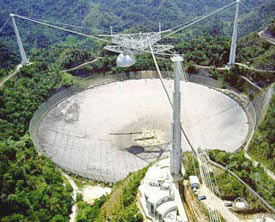
The 1,000-foot (305-meter) dish at Arecibo, Puerto Rico, is the most sensitive radio telescope in the world. It was used by Projects Phoenix and SERENDIP, and it's currently feeding huge volumes of data to SETI@home.
David Parker/ Science Photo Library
Using a truck trailer filled with custom-built equipment, Project Phoenix traveled to radio telescopes around the world to monitor its chosen stars. It spent its final six years encamped at the 305-meter Arecibo radio telescope in Puerto Rico, the world's largest, where it had the use of the huge dish for about 5 percent of the time.
Project Phoenix scanned more than two billion radio channels between 1.2 and 3.0 gigahertz with a razor-thin resolution of 0.7 hertz per channel. Any signal this narrow in frequency would surely be artificial. By comparison, the narrowest microwave frequency produced anywhere in nature (by an interstellar maser) is about 300 hertz wide.

The mesh of the Arecibo dish lets sun and rain reach the ground below, allowing plants to thrive and stabilize the slopes against erosion.
Copyright 2003 Ron Hipschman
Project Phoenix rose from the ashes of an ambitious SETI search designed by NASA, which Congress canceled in 1993 soon after it had gotten started. Capitalizing on the $58 million already spent, the privately funded SETI Institute secured the equipment to continue the targeted-search half of the NASA project. (The other, more important half, a less sensitive but very wideband survey covering much of the Milky Way, was lost.) The SETI Institute has been funded by several large donors from the high-tech industry, where SETI has long fired imaginations. (For instance, see the Wall Street Journal article from Feb. 13, 2009, on the SETI Institute's Jill Tarter winning high tech's influential $1 million TED Award.) The SETI Institute is funded to a lesser extent by many small donors; memberships start at $50 per year.
As Project Phoenix ended, a more ambitious effort was taking its place. Phoenix components were upgraded and moved to the next-generation Allen Telescope Array (ATA), which the SETI Institute has built in northern California. The ATA, if expanded to its full intended size, should ultimately be able to examine 1 million or more stars individually, and it has wide-field SETI abilities as well. In October 2007 the SETI Institute announced that the ATA's first 42 dishes had begun science observations. If enough money appears, the ATA plans to expand to 350 dishes. By April 2009, ATA-42 was successfully making various astronomical sky-survey observations, as described by Welch and Tarter in a paper detailing the system's construction and performance.
In May 2009, ATA-42 began searching for artificial signals in a sweep of the Milky Way's plane toward the galactic center. The area of sky being covered by this Galactic Center Survey is 2° by 10° in size. That's only one two-thousandth of the celestial sphere, but it's an extremely star-rich area, including about 40 billion stars within 30,000 light-years. The survey is covering all the frequencies in the broad “waterhole” range from 1420 to 1720 MHz. More details.
Strengths: Project Phoenix examined nearby stars for artificial signals in greater depth than any other program. It spanned a wide fraction of the "microwave window," nearly 2 gigahertz worth. It was built around robust methods for distinguishing false alarms from a real interstellar signal, including simultaneous observations by the 76-meter Jodrell Bank radio dish thousands of kilometers away in England. This would allow it to chase down and confirm a genuine signal in real time, a big plus; sorting out false alarms caused by the massive radio interference from human civilization is a severe problem for all radio SETI efforts.
Weaknesses: Phoenix looked at only a paltry 800 or so stars out of the billions in our galaxy.
Continued; click "Next Page" below.
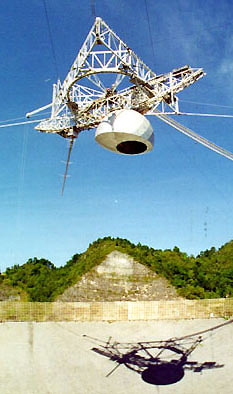
Antennas over the Arecibo dish. The dome contains the receivers that most radio astronomers use. Another receiver (hidden by the long 430-Mhz 'line feed' at left) collected the signals for Project SERENDIP and the original incarnation of SETI@home.
NAIC / Arecibo Observatory / Tony Acevedo
Project SERENDIP
SETI researchers have always had trouble getting valuable radio-telescope time for their admittedly chancy pursuits. Yet telescope time, vast quantities of it, is what the search demands. Project SERENDIP neatly sidesteps this problem. The idea is to "piggyback" an extra receiver onto a radio telescope without getting in the way of the telescope's other work. This idea was originally conceived by SETI researchers at the University of California at Berkeley. Since 1978 they have carried SERENDIP through five big stages of evolution.
SERENDIP (then in version IV) gave birth to the famous SETI@home. The receiver is suspended high above the Arecibo dish, and scans the sky for narrowband signals wherever it happens to get pointed. The aiming of Arecibo is controlled by other radio astronomers working on their own projects. Although SERENDIP can't choose where it looks, it can run essentially around the clock all year. (In practice, however, data can be collected less than half the time.)
Starting in the fall of 1998, SERENDIP IV listened to 168 million radio channels simultaneously, each 0.6 hertz wide, comprising a band 100 MHz wide centered on the hydrogen emission frequency of 1,420 MHz (21 centimeters wavelength).
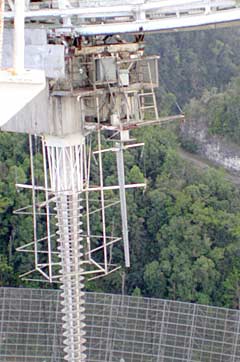
Antennas over Arecibo seen from a precarious perch close up. At left is the massive 430-MHz line feed (with rings). Centered is the shorter 1420MHz line feed that caught the signals for SERENDIP IV and the original version of SETI@home.
Copyright 2003 Ron Hipschman
Frequencies close to this "21-centimeter line" have long been favored by SETI researchers, for two reasons.
First, it is an important frequency in radio astronomy (since hydrogen is the most common element in the universe), so maybe alien engineers would choose it as a logical hailing frequency where other astronomically minded civilizations would think to listen. But that argument is less compelling now than when it was first proposed in 1959, during radio astronomy's early days. Since then radio astronomers have found many other important cosmic emissions and have proposed countless other "magic frequencies" where extraterrestrials might logically try hailing instead.
The second reason for choosing the hydrogen line is more down-to-Earth. Frequencies around it are supposed to be protected for radio astronomy, so Earthly interference problems are less severe than elsewhere in the radio spectrum.
SERENDIP IV repeatedly scanned most points on the sky between about declination +2° and +35°. That's about 30 percent of the entire sky. (Arecibo can't see any farther north or south because the dish points straight up; its view is limited to the band of sky that passes near Puerto Rico's zenith.) Potentially interesting signals that survived false-alarm tests were kept on file. The most important test is whether a signal repeats when the same point on the sky gets scanned again. Dedicated follow-up observations at the locations of the best candidate signals have been part of the plan.
Project scientist Dan Werthimer says that first looks at the SERENDIP IV data have turned up nothing obviously exciting. Full analysis of the data will take more time.
SERENDIP IV went idle in 2007. The new, much improved generation is SERENDIP V. It uses Arecibo's same new ALFA multibeam receiver as the current version of SETI@home, "SETI@home II." SERENDIP version Vb was installed at Arecibo in June 2009. From the SERENDIP website:
"SERENDIP Vb is the most powerful spectrometer yet. . . . When complete, it will channelize over 2 GHz of instantaneous bandwidth (7 beams x 300 MHz) at less than 2 Hz resolution."
This version brings several major improvements over SERENDIP IV. It is not only five times more sensitive, it listens to 300 megahertz of radio channels at once instead of 100 MHz. It also listens at two polarizations instead of one, and will eventually monitor all seven beams of the ALFA multibeam receiver.
In addition, the seven independent beams (pointing directions) can reduce false alarms and help provide a fast first cut at confirming any real signal.
Strengths: SERENDIP uses the world's largest radio telescope to scan a fair fraction of the celestial sphere. This means it samples many billions of Milky Way stars and many thousands of background galaxies. No one star gets as deep a scrutiny as Project Phoenix provided, but the number of stars being scanned is immense.
Weaknesses: No real-time followup yet. This is a problem for piggyback SETI, partly because weak signals from beyond several hundred light-years should fade in and out of audibility, on a timescale of minutes, due to "interstellar scintillation" caused by the thin gas between the stars. Therefore several repeat observations of each point on the sky will probably be needed to catch a single repeat of a continuous weak signal. And, of course, if the aliens turn their transmitter elsewhere (or off) before a dedicated followup is scheduled, the chance to confirm a signal disappears.
Continued; click "Next Page" below.
SETI@home
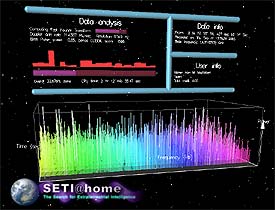
As of 2010, SETI@home was chugging away on about a quarter million computers. The screensaver gives a graphical view of what it's doing on yours at each moment.
Sky and Telescope illustration
UPDATE NOVEMBER 2016: Most of this article is quite old, as you've surely realized by now. Dave Anderson of SETI@home has just published a comprehensive overview of SETI@home's current status, methods, results, goals and future, following its first 17 years: Nebula: Completing the SETI@home pipeline.
-----------------------
In 1999, SERENDIP spun off an imaginative project that quickly became the most exciting landmark in the SETI movement's 48-year history.
Sifting through huge volumes of radio data for narrowband signals takes massive computing power. Given limited budgets, this is a critical bottleneck in the search. Even the powerful supercomputer specially designed for SERENDIP must limit itself to looking only for simple signals with certain predetermined characteristics.
In 1994 David Gedye, a Seattle computer scientist, had a brainstorm. He realized that deeper analysis of SETI radio data would be a perfect project for "distributed computing" by tens of thousands of volunteers using home computers. Development of the project stalled in 1998 due to fundraising problems, but The Planetary Society saved the day by putting up a matching grant of $50,000 (from its Carl Sagan memorial Fund for the Future) and then persuading Paramount Pictures to grant $50,000 for the society to match. As a result, the SETI@home project burst onto the world in May 1999 and has been running ever since.
The idea is simple. You download a program that can install itself as your computer's screen saver if you wish. It then fetches files of data ("work units") recorded by the SERENDIP radio receiver. The program unobtrusively mulls over the data whenever your computer has nothing else to do. When the analysis is done (typically after 2 to 10 hours of processing time per work unit, depending on the speed of your CPU and memory), your computer sends back the results and downloads more work units to chew on.
SETI@home became wildly popular the moment it was unveiled. As of April 2010, ten years into the project, more than 8 million people from nearly every country in the world had run SETI@home for at least a while. As of May 2009, 140,000 were running it enough of the time to be classified as "active users."
What It Does
SETI@home analyzes only one narrow, 2.5-MHz segment of SERENDIP's much wider band. The chosen segment is usually centered on the 1,420-MHz hydrogen line. It is wide enough that a transmitter broadcasting exactly at the hydrogen frequency could be moving toward or away from Earth by up to 270 kilometers per second and still be picked up despite the resulting Doppler shift. This velocity range is wide enough to include most of the stars and planets in the Milky Way (at least in the part of the sky accessible to Arecibo) but generally none in any other galaxies.
Within this 2.5-MHz band, SETI@home provides several important boosts to Project SERENDIP. It increases the sensitivity tenfold, thereby enlarging the volume of space that SERENDIP listens to (for a transmitter of a given power) by a factor of 103/2, or about 30. That means 30 times more stars and planets get searched. SETI@home also broadens SERENDIP's ability to discriminate signal widths; it looks at channels that range from 0.075 to 1,220 hertz in bandwidth.
The software can also spot signals that drift in frequency, by as much as 50 hertz per second. A very narrow signal from deep space is expected to show at least a slight frequency drift (up to 0.14 hertz per second as seen by Arecibo) for a simple reason: the receiver is on a rotating planet! An alien transmitter might be too. If the transmitter is in space, it might be in some kind of rapid orbit giving the signal a greater frequency drift. For instance, a transmitter in a low orbit around an Earth-mass planet would show changing Doppler drifts of up to 40 hertz per second.
Each work unit that you receive from SETI@home represents 107 seconds of listening time by Arecibo and about 10 kilohertz of bandwidth. So it takes 256 work units, lined up side by side, to cover the experiment's entire bandwidth for those 107 seconds.
During that brief time, the receiver's beam usually sweeps about 0.3° to 0.6° across the sky, depending on what else the telescope is doing. The beam is about 0.1° wide, so your work unit represents a scan of a tiny strip of sky 0.1° wide by 0.3° to 0.6° long — about as much sky as would be covered by a small rice grain held at arm's length.
As with SERENDIP, promising signals that are analyzed out of the data (and that don't match known radio-frequency interference) will be followed up with dedicated observations. In March 2003 the SETI@home team got its first chance to take control of the Arecibo radio telescope and use it for dedicated followups. At 155 promising signal sites (and 61 other interesting SETI target sites), nothing striking turned up. Fuller analysis of all the SETI@home signals (3.4 billion were on file as of March 2009) will take much longer.
Continued; click "Next Page" below.
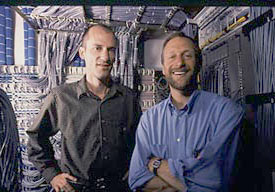
The central brains behind SETI@home. Early in the project, director David P. Anderson (left) and chief scientist Dan Werthimer posed in the Berkeley Space Sciences Laboratory wiring closet through which SETI@home communicates with its users.
Sky & Telescope / Peg Skorpinski
The vast SETI@home network of volunteers is, in effect, one of the world's most powerful supercomputers (averaging 480 teraFLOP per second as of November 2008). In fact, for a long time it was overpowered. In the first six years the Berkeley lab never managed to put all the volunteers to full use. For instance, by April 2005, the lab had "split" (created) 228 million work units from its data tapes laboriously recorded at Arecibo. But it had sent out 1,618 million work units to meet the volunteers' demand. The difference was made up by sending out duplicates. Lots of duplicates.
Having each work unit processed by at least two (or three) people independently provides an essential check for eliminating bad results, such as occasionally come from malicious hackers or from users overclocking their computers (setting a computer chip to run at a faster megahertz speed than it is rated for, which can cause it to miscompute). But bad results are rare, so processing a work unit more than three times serves no purpose.
In 2005, however, this embarrassing waste of computing power (and electricity!) was remedied.
The software for volunteers was overhauled to create a system called BOINC, the Berkeley Open Infrastructure for Network Computing. This gives users the flexibility to divide their computer time between SETI@home and other distributed-computing projects, such as the 80 or so that are now (May 2009) under way in molecular biology, climate modeling, physics, and mathematics. According to the SETI@home website, "Each work unit is now processed a limited number of times. When we have no work for your computer, you'll get a 'no work available' message. We encourage you to participate in other BOINC-based projects; then, when SETI@home has no work, your computer can stay busy doing other scientific research." The transition from "SETI@home Classic" to SETI@home/BOINC was completed in December 2005.
New SETI@home Directions
Meanwhile, the Berkeley team was working to expand SETI@home into other new realms:
1. The biggest change was inaugurated in the summer of 2006. SETI@home's old "line feed" antenna above the Arecibo dish was finally shut down, and the project instead began to record data from the five-times-more-sensitive ALFA multibeam receiver, which was installed at Arecibo in 2004. It looks at seven spots in the sky ("beams") at once instead of just one, so SETI@home now has seven recorders swallowing different data at once. And each records radio waves with two polarizations, not just one, making for 14 times as much data with 5 times the sensitivity.
In addition, the new SETI@home software, with which volunteers' computers analyze the new multibeam data, is itself five times as sensitive as the old. And the new receiver arrangement is more impervious to radio interference from Earth. More about the rejuvenated SETI@home appeared in a Planetary Society SETI Update.
One thing this means is that SETI@home now needs more volunteers. If you've waited because you don't want to waste your computer's time on unnecessary duplication, wait no more. Those days are over.
2. A separate, new branch of SETI@home is a project called AstroPulse: a different type of analysis to search existing SETI@home data for extremely brief, wideband radio pulses. This is something that's never been done well before. Astronomers think that such pulses could, theoretically, come from several possible sources: ETs trying to catch attention, exotic processes on neutron stars, and evaporating mini- black holes that might be left over from the Big Bang.
After years of preparation, AstroPulse finally went online in August 2008. SETI@home users automatically receive the AstroPulse analysis software, and the 8-megabyte work units that it dissects, without having to take special action. Your computer divides its time between AstroPulse and SETI@home proper.
In addition, the Berkeley SETI team is running a second radio pulse-search project, called Fly's Eye, using the Allen Telescope Array in California. While AstroPulse is very sensitive but sees only tiny bits of the sky at a time, Fly's Eye watches huge areas of the sky (100 square degrees at once, 3,000 times as much as AstroPulse sees), but at much lower sensitivity. So the two projects are complementary. Fly's Eye began in early 2008. Here is a detailed paper (November 2008) about both AstroPulse and Fly's Eye.
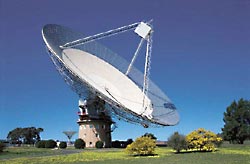
The 64-meter Parkes Observatory dish in Australia is one of the largest radio telescopes in the Southern Hemisphere. If funding comes through, it too could supply masses of data to SETI@home.
John Sarkissian / CSIRO
The SETI@home team has also looked into enlarging the search to the southern half of the celestial sphere — important sky territory that Arecibo cannot see. This project would piggyback on the 64-meter Parkes radio telescope in Australia, which is already hosting the Southern SERENDIP program (described below). It too has a multi-beam receiver.
"All of this is funding-contingent," Werthimer warns. SETI@home is continually seeking donations (tax-deductible) so it can continue with its plans.
In May 2009, SETI@home celebrated its 10th anniversary. The SETI Institute and Planetary Society sent out a press release for the occasion, noting, among other things, that SETI@home is currently "funded by donations from volunteers. . . . But [Werthimer] and Anderson intend to keep it running as long as there is interest.
“ 'We’re in this for the long haul. We’re looking for a needle in a
haystack. It could take a hundred years,' Werthimer said. 'As long as
we have some way to increase the sensitivity of our radio detectors or
the frequency range or the part of the sky we’re looking at, we’ll
still be doing something worthwhile.' ”
Strengths: SETI@home is performing the deepest wide-sky survey of the 21-cm frequency that has ever been done, and that can be done with current equipment. It has grown as new technology comes available, has expanded public understanding of SETI issues, mobilized enthusiasts and made them aware of their numbers, and blazed the trail that other distributed-computing projects have followed.
Weaknesses: SETI@home is basically a 21-cm survey. If we haven't guessed right about the alien broadcasters' choice of hailing frequency, the project is barking up the wrong tree — in a forest of thousands of trees. Secondly, there has been little real-time followup of interesting signals. Lack of immediate, dedicated followup means that many scans are needed of each sky position — in order to deal with the problem of interstellar scintillation if nothing else.
With its first, single-feed receiver, SETI@home logged at least three scans of more than 67 percent of the sky observable from Arecibo, amounting to about 20 percent of the entire celestial sphere. Of this area, a large portion was swept six or more times. Werthimer says that a reasonable goal, given issues such as interstellar scintillation, is nine sweeps of most points on Arecibo's visible sky.
Continued; click "Next Page" below.
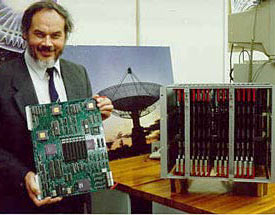
Frank Stootman, director of the SETI Australia Centre, holding the heart of Southern SERENDIP, one of the 14 boards that together can sift through 58.8 million radio channels, as of a few years ago.
Carol Oliver
Southern SERENDIP
A lot of SETI action has been happening elsewhere than at Arecibo. In March 1998, a near-copy of the earlier SERENDIP III receiver began piggybacking on the 64-meter radio dish at Australia's Parkes Observatory, the largest radio-astronomy telescope in the Southern Hemisphere. Run by the SETI Australia Centre (University of Western Sydney Macarthur), Southern SERENDIP was upgraded in 1999 from 8.4 million to 58.8 million channels. Each channel is 0.6 hertz wide, for a total bandwidth of 35 MHz. This band can be tuned to listen at any frequencies between 1.2 and 1.5 GHz, while the rest of the telescope goes about its regular programs such as hunting for pulsars and surveying hydrogen clouds in the Milky Way.
The project has been ticking along ever since. In May 2008, SETI Australia Centre director Frank Stootman gave this update: "We are actually in the process of revamping the machine as I write. The machine is back from Parkes in our lab for maintenance and upgrading. We have added a new control computer and written modern control software running under Microsoft XP. Our hope is to bring it back online by July/August.
"The new software will improve the communication between Serendip and the outside world. We are producing client software which will allow a limited number of sites to have direct access to data as it is produced. This (hopefully) will interest museums particularly. We intend to add instantaneous data analysis to the client software to make the whole adventure more immediate."
Strengths: Southern SERENDIP is surveying a large fraction of the entire sky, including the southern half of the celestial sphere. It can therefore scan most of our Milky Way galaxy's enormous volume — most of which lies south of the celestial equator and is out of Arecibo's sight.
Weaknesses: The antenna has a fifth the diameter (and thus 1/25 the collecting area) of Arecibo. And as with other piggyback programs, there is no real-time followup.
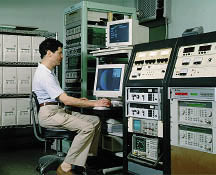
Paul Horowitz in the control room of Project BETA in Harvard, Massachusetts.
Paul Horowitz
Project BETA
Starting in the early 1980s several sky surveys were carried out by Paul Horowitz of Harvard University and his graduate students, using a 26-meter dish in the town of Harvard, Massachusetts. The culmination of these efforts was Project BETA (Billion-channel Extra-Terrestrial Assay). Supported by The Planetary Society and private donors, Horowitz and his team systematically swept the sky from declination –30° to +60° four times from October 1995 until March 1999, when one of the antenna's mounting gears broke in a wind storm.
Project BETA scanned a very wide frequency band, from 1.40 to 1.72 gigahertz, at 0.5-hertz resolution. This frequency range has been dubbed the "water hole" because it is marked on either end by important emissions from hydrogen (H) and hydroxyl (OH), components of the water molecule. The hope is that extraterrestrials wishing to be noticed might also choose a frequency somewhere in this well-marked band, water being so important to life. Even if the ETs aren't thinking this way, this band is wide enough that it has some chance of catching a transmitter at a random frequency chosen for reasons we can't guess.
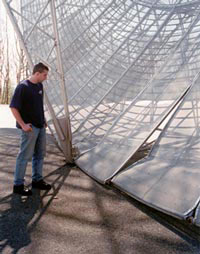
In March 1999 the 26-meter Project BETA dish broke its right-ascension gears in a wind storm and slammed into the ground.
Paul Horowitz
Following an appeal to its members, The Planetary Society raised funds toward repairing the dish and getting Project BETA back on the air. But straightening out the surface of the dish, a high-precision job, turned out to be more costly than expected, and so the repair project ended. Planetary Society executive director Louis Friedman says the society decided to shift funding from the dish repair to Horowitz's new optical SETI project, described below. Sadly, the historic but now useless radio telescope was finally dismantled in May 2007.
Strengths: BETA scanned 68 percent of the celestial sphere across a wide frequency band. This is the optimum kind of SETI strategy if, as seems most plausible, the alien transmitters that we might actually be able to hear are very rare but very powerful (see "Smarter SETI Strategy.") BETA also used elegant methods to check interesting signals, reject false alarms, and perform real-time followups of potential genuine signals before fading due to interstellar scintillation could take effect.
Weaknesses: A small, relatively insensitive dish.
META II becomes Southern SETI
BETA replaced the more limited Project META (Million-channel Extra-Terrestrial Assay), built by Horowitz and his students in 1985 and installed on the same Harvard radio telescope. From 1986 to 1991, META searched 60 percent of the celestial sphere in narrow, carefully chosen frequency bands very close to the 1,420 MHz hydrogen frequency and its second harmonic (2,840 MHz).
META's hardware was duplicated in the Southern Hemisphere by the Instituto Argentino de Radioastronomia (IAR), with funding from The Planetary Society. Called META II, this search used a pair of 30-meter antenna dishes near Buenos Aires, starting in 1990, to survey nearly half the sky repeatedly between declination –90° and –10°. Paralleling the first META, it monitored 8.4 million very narrow, 0.05-hertz channels close to the hydrogen frequency and its second harmonic. In 1997 it was upgraded to newer technology.
The director of META II, Guillermo Lemarchand, said in August 2004 that the project was then observing natural hydroxyl masers in interstellar gas clouds, in case ETs are using these as natural signal amplifiers. Literally "astronomical" signal-strength boosts — of up to a trillion times — are theoretically possible through this means, though only in fixed, extremely narrow pointing directions.
In 2009, thanks to another grant from The Planetary Society, the META II back end was being replaced with a state-of-the-art SERENDIP V system, designed by Dan Werthimer's team at Berkeley. The SERENDIP V receiver and signal processor will expand the Argentine search from 8.4 million to 128 million simultaneous channels, and from a total bandwidth of 0.42 MHz to 80MHz with wider channels. This is crucial; the old bandwidth was so narrow that a signal could have been detected only if the alien transmitter was carefully compensating for Earth's motions, hardly likely.
At the same time, LeMarchand was working with international partners to develop the optimal software for operating the system. As of 2008, The Planetary Society was estimating that the SERENDIP V upgrade would be on the air in summer 2009.
The Argentine project is currently named Southern SETI; the META II moniker has been retired. "If anyone is hailing us from the center of our galaxy, chances are that it will be the new Southern SETI that will hear the call," wrote Amir Alexander in the Nov.-Dec. 2008 issue of The Planetary Society's magazine, The Planetary Report.
Strengths: Southerly location, which allows most of the Milky Way's bulk to be scanned, not just the Northern Hemisphere's fringe. State-of-the-art signal detection and processing (once the SERENDIP V upgrade is online).
Weaknesses: The small antenna aperture means low sensitivity.
SETI Italia
Other projects have been carried out around the world in recent years. Radio astronomers in Italy piggybacked a 24-million-channel version of the SERENDIP IV spectrum analyzer onto a 32-meter dish in Medicina, run by the Institute of Radioastronomy in nearby Bologna. SETI Italia covers 15 MHz of bandwidth at 0.6 Hz resolution. "It is planned, within a period of less than six years, to survey at least 50 percent of the sky observable from Medicina," wrote Stelio Montebugnoli, chief engineer of the Medicina station, in 2002. In addition, says Montebugnoli (August 2004), "At present I am developing a low-cost spectrum analyzer with 64 million channels and 50 MHz of input bandwidth."
SETI Italia is using a new signal-processing algorithm that can recognize a wide variety of complex artificial signals, not just the simple, narrowband ones that most SETI programs listen for. The so-called KLT transform "is able to detect any kind of radio signals embedded in the noise," Montebugnoli told a Spanish interviewer (August 2004). "We still have a lot of work to do to make this transform efficient. . . . When we will have it working more efficiently I am planning to distribute it free." Radio engineers at the institute are also developing better algorithms for separating interstellar signals from Earthly noise in piggyback SETI data.
And More. . .
In April 2010 the European agency ASTRON in the Netherlands announced that its LOFAR array (designed for high-resolution radio astronomy at poorly explored, relatively lowfrequencies) would embark on a SETI project targeting nearby stars. LOFAR was still under construction but already producing science images. "The first phase of this SETI program will study how contamination from terrestrial transmitters can be weeded out and show the sensitivity of LOFAR for SETI work," according to a press release. "An extended program of looking at the nearby stars is then planned. The first high-spectral resolution spectrum in the test program has just been obtained."
At NASA's Jet Propulsion Laboratory, a small, internally funded group has carried out a pilot study for a wide-sky SETI survey — in hopes of getting back in the game years after Congress pulled the plug on the original NASA SETI projects. Steven Levin and a few others at JPL worked on a proposal for a new, updated version of NASA's wide-sky survey — the project that the SETI Institute did not pick up after federal funding for it ended in 1993.
The potential power of such a survey has grown greatly since then, what with a decade of signal-processing advances. "We're working on a pilot study now," Levin told Sky & Telescope in September 2004. Using a spectrometer loaned by Dan Werthimer (University of California, Berkeley), the group was using a 34-meter dish to scan along the galactic plane with a 2.5-megahertz bandpass, "to learn what we could do with a 20-gigahertz bandpass," Levin says. The scan covered the star-dense band of sky within 2° or 3° of the galactic equator. Its spectral resolution was 2.4 hertz per channel. Levin said at the time that the group hoped to follow up with a 100-MHz-wide survey, with the ultimate hope of listening to the entire microwave spectrum from 2,000 to 22,000 MHz — a vastly greater range of frequencies than any survey has yet attempted.
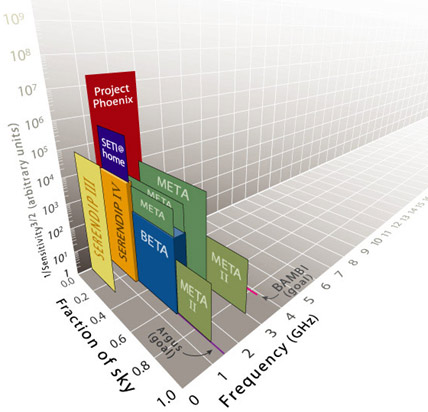
The search space of the major SETI programs as of 2000. The three axes show the frequencies that a project scans, how much of the sky it looks at, and its sensitivity.
The sensitivity axis is scaled in units that indicate the relative volume of space (number of stars) examined in a given direction for an alien transmitter of a given power. The graph shows, for instance, that SETI@home I (a narrow extension of Project SERENDIP IV) listened only near a frequency of 1.420 gigahertz, but that it surveyed a greater volume of space at this frequency than was ever looked at before.
There are more parameters to consider than the three graphed here — for example a signal's frequency drift, on-off duty cycle, and polarization. Plotting them all, says Jill Tarter of the SETI Institute, would require a 9-dimensional graph. The 'haystack' to be searched for the 'needle' of an alien signal is huge indeed."
Since the early 1960s, according to a count by Jill Tarter of the SETI Institute, there have been 101 much more fragmentary or limited SETI projects of one type or another. Many of these were run by astronomers who had access to spare time on radio-astronomy gear and a particular brainstorm to try out. Others looked at data that were collected for other purposes for signs of anything artificial. Tarter has posted her list of historical SETI programs.
And yet, estimates Guillermo Lemarchand, all the searches to date have looked at only 10–14 — that's a hundred-trillionth — of the "cosmic haystack" of frequencies, sky directions, and other parameters that need to be sifted for the "needle" of an artificial signal.
Continued; click "Next Page" below.
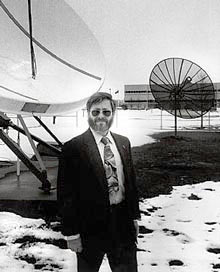
H. Paul Shuch, executive director of the SETI League, says that properly equipped amateur radio astronomers could fill a meaningful niche in monitoring the sky for powerful intermittent signals.
SETI League
Amateur Participation
Like other areas of astronomy, SETI can benefit from the efforts of amateurs — and not just by using their idle computer time. A powerful beacon elsewhere in the galaxy could easily fall into the enormous coverage gaps of the major SETI programs, yet be detectable with nothing more than a properly equipped home satellite dish and narrowband signal analyzer. These small dishes have a much wider beam that can cover more sky for a longer time than large radio telescopes. Amateurs thus can increase the breadth of coverage, though at the expense of much less depth (lower sensitivity and noise rejection).
Examples of small-scale SETI efforts include Project BAMBI ("Bob And Mikes' Big Investment"), a pair of small, 3.1-million-channel radio telescopes intended to observe in parallel from California and Colorado 1,000 miles apart to screen out local interference. Bob Lash, Mike Fremont, and Mike Fox designed their setup to explore frequencies near 4 GHz, higher than other searches. "To up the odds a bit," writes Mike Fox, "we have decided to point our dishes straight down our spiral arm [of the Milky Way]. This gives us the maximum number of stars in each patch of the sky we are looking at."
As of August 2003 both BAMBI stations were being upgraded to 12-foot (4-meter) dishes, according to Bob Lash. He also said the team may use the BOINC distributed-computing spinoff of SETI@home to recruit volunteer data processors; "We might call the project 'bambi@home.' "
Another example is Robert Gray's Small SETI Radio Telescope, which carried out various projects starting in 1983. Gray was also granted time on the Very Large Array radio telescope in New Mexico — quite an accomplishment for an amateur — to follow up on the famous "Wow signal" recorded in 1977 at Ohio State University's Big Ear. (No trace of a signal from the "Wow" location showed up even with the VLA's vastly greater sensitivity.) More recently Gray monitored the Wow site for extended lengths of time using a 26-meter dish in Tasmania.
Starting in 1995 the SETI League, directed by H. Paul Shuch in Little Ferry, New Jersey, made ambitious plans to coordinate amateur stations worldwide through its Project Argus (not to be confused with Ohio State University's next-generation Argus omnidirectional radio telescope). The SETI League's ultimate goal was to have 5,000 small, amateur radio telescopes around the globe monitoring the entire celestial sphere continuously. In many cases, such observing stations have cost their builders only several hundred to several thousand dollars. The SETI League offers technical guidelines and help in getting parts and software.
However, the SETI League never came anywhere near its goal of 5,000 installations. Among the League's 1,476 members as of July 2006, there were 131 Project Argus participants, and that number had barely budged in the last several years. Moreover, donations were down.
"It's time to redefine our objective for Project Argus," Shuch wrote. "Instead of full-sky coverage, perhaps what we should be striving for is the very best science we can do with however many stations we can muster." Among other things, the SETI League has built a beacon that bounces a weak, narrowband signal off the Moon so that SETI workers worldwide have a celestial standard for testing and calibrating their equipment. More recently the League obtained a patent for a new method of combining signals flexibly from small radio telescopes, based on a prototype SETI instrument named the Very Small Array that Shuch and other members have built.
James Brown of Del Mar, California, is a prolific SETI League member who started building amateur SETI gear in 1978. He has written extensive astronomical, coordination, and signal analysis software, which he shares worldwide through his seti.net website. In April 2005 he received the League's Giordano Bruno award for his ongoing work. As of 2011 he was using a 10-foot dish; knowing its limited capabilities, he was using it to monitor the L4 and L5 stable Lagrangian points, just 1 a.u. away in Earth's orbit, for any beacon transmitter that aliens may have parked there long ago.
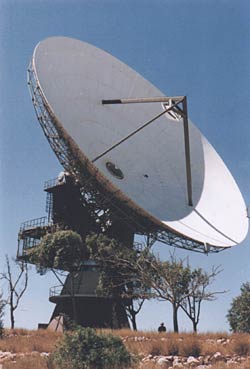
Amateur telescope? Australian SETI amateurs are working to obtain use of this 33.5-meter dish at Carnarvon.
Noel C. Welstead
Amateurs in Australia have been developing several SETI installations through the SETI Research & Community Development Institute. Among other things, members of the group have sought rights to an old but huge, fully steerable, 33.5-meter (110-foot) dish at Carnarvon. SRCDI director Noel C. Welstead wrote (December 2003) that it will take "a few more years of work running through the government red tape to fully secure the use of this impressive antenna. We can't wait."
Meanwhile, he wrote, "We are constructing the Boonah SETI Observatory, where we will be conducting searches in both the optical and radio spectrums. We recently had 'first light' with our 5-meter Argus station," detecting the weak Project Argus signals bounced off the Moon. "Also, construction has commenced on the twin 40-foot [12-meter] dishes that will be our primary
ears to tune into the universe. Our optical facility has seen first light with the commissioning of the 14-inch Schmidt-Cassegrain telescope. Work has begun on the optical detectors that will get the optical SETI project up and running."
Strengths: Enough small amateur radio telescopes, running continuously, could watch large swaths of the sky all the time in case alien radio emissions at a well-guessed frequency are strong but intermittent.
Weaknesses: Mostly tiny apertures, tiny bandwidths (though this should improve), labor-intensive signal analysis, unsophisticated false-alarm rejection — and members' unpredictable commitments to very long-term, long-shot projects.
Continued; click "Next Page" below.
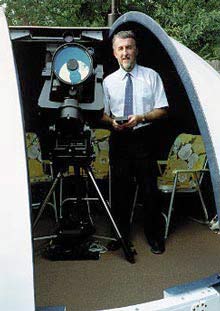
Radio isn't the only way signals could be sent 1,000 light-years or more. Stuart Kingsley ran a search for nanosecond optical pulses and continuous laser signals from hundreds of Sun-like stars using a 10-inch telescope and special photometers.
Stuart Kingsley
Optical SETI
Searches today are not limited to microwave radio. As early as 1961 Charles H. Townes (co-inventor of the laser) and Robert N. Schwartz proposed that laser signaling would be an attractive alternative to interstellar radio. Stuart Kingsley of Columbus, Ohio, picked up on this idea and championed it for years. His small Columbus Optical SETI Observatory performed a pioneering targeted search of stars — both for narrowband laser signals and for extremely brief pulsed signals — at visible wavelengths using just a 10-inch amateur telescope and commercial equipment.
Optical SETI finally entered the scientific mainstream by the late 1990s. Analyses by Kingsley, Paul Horowitz, and many others demonstrated that brief, nanosecond laser pulses would indeed be a very attractive means of interstellar communication. A laser no more powerful than those already on engineers' drawing boards might direct a short burst of beacon signals to perhaps a million stars each day. Such signals could be detected across 1,000 light-years by today's best optical telescopes. If the aliens use a bigger laser, the signals could be detected by an amateur telescope equipped with a pair of low-cost high-speed photomultipliers.
Such a brief, pulsed signal would be so clear — and so plainly artificial — that we could see it by watching a single, wide-frequency channel spanning much of the visible or infrared spectrum! This sounds very attractive compared to radio SETI, where we are laboriously sifting through billions of narrow channels for a continuous signal. Nor are optical signals subject to the interstellar scintillation that degrades radio signals. Would ETs make the same judgments?
For more on this idea and possible amateur participation, see Kingsley's Optical SETI Network site. Kingsley and laser communications expert Monte Ross hoped to start an amateur optical SETI project, named PhotonStar, but it has not happened. However, high-end amateur CCD cameras (made by SBIG) should soon have nanosecond optical SETI capability built in, so such a project could yet get off the ground.
At Harvard, Paul Horowitz has looked for nanosecond pulses in the light of thousands of Sunlike stars. The Harvard Targeted Optical SETI Project was an example of piggybacking applied to optics. The stars were already having their radial velocities measured by a spectrograph on Harvard's 61-inch telescope. About a third of a star's light reflects off the jaws of the spectrograph slit and is normally lost. Horowitz and his group designed their SETI instrument to capture and examine this wasted light while the telescope went about its other business.
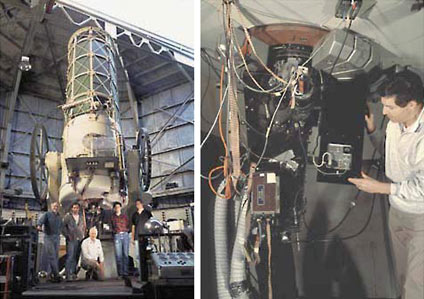
The Harvard Targeted Optical SETI Project. The 61-inch reflector in Harvard, Massachusetts, a near-antique from the 1930s, measured precise radial velocities of thousands of stars in a search for orbiting companions. This work used the long, dark Echelle spectrograph extending from the center of the telescope's back (right). Unused starlight that reflected off the jaws of the spectrograph slit was captured and analyzed for billionth-of-a-second flashes by the optical SETI camera attached to the side, being held by Paul Horowitz.
Paul Horowitz.
The project began observations in 1998 and was soon recording lots of signals — from electrical discharges in the equipment during humid weather and, perhaps, from cosmic-ray events in the atmosphere and radioactive decays in glass parts. Most of these problems were eventually solved. The program logged good observations of 6,176 stars for a total of 2,378 hours, or an average of 23 minutes per star.
False signals still came about once a night. To eliminate these, the Harvard group recruited volunteers at Princeton University, several hundred miles away, to set up a duplicate detector on Princeton's 36-inch telescope. "When this telescope is coordinated with the Oak Ridge 61-inch, we can be sure that short pulses of light seen simultaneously by both systems are truly from astronomically distant sources," wrote Horowitz. The Princeton Optical SETI program began coordinated observations with the Harvard telescope in November 2001. It watched 1,397 stars for a total of 494 hours thanks to amateur volunteers. (Only some of this time was in dual-observing mode with Harvard; the dual-observing log included 1,142 stars watched for 244 hours.)
After about five years the Harvard targeted project came to an end. A detailed paper on the project and its results appeared in the October 1, 2004, Astrophysical Journal. The Smithsonian Institution ceased funding any operations at the 61-inch telescope as of August 2005, and the telescope itself, the largest all-purpose astronomical telescope east of the Mississippi, was reportedly to be dismantled.
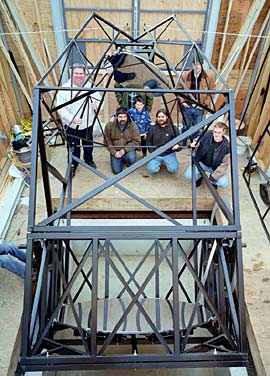
The 1.8-meter telescope of the Harvard All-Sky Optical SETI Project, under construction in 2002. The objective mirror (bottom) sends starlight to the large, tilted secondary (top), which reflects the beam to an instrument package mounted on the side (not yet added here).
Paul Horowitz
Since then, however, Horowitz and his students have built an all-sky, rather than just a targeted, optical survey instrument. The Harvard All-Sky Optical SETI Survey, funded by The Planetary Society, uses a short-focus, 1.8-meter (72-inch) "light bucket" telescope aimed at the meridian. A grid of nanosecond-speed pulse detectors in its focal plane covers a patch of sky measuring 1.6° by 0.2°. This patch scans a strip of declination continuously as the Earth's rotation moves the sky from east to west across the telescope's view. The telescope always points at the sky's north-south meridian; it can only move its aim up and down, not side to side.
The system gives not just a few stars but every point on more than half the celestial sphere (from declination +60° to –20°) at least 48 seconds of examination in the course of just 200 clear nights.
The stubby 72-inch telescope, with its state-of-the-art detector array, was dedicated on April 11, 2006 (see our article). It is housed in a roll-off-roof observatory only a few yards from the site of the old 61-inch. As of November 2009 it had performed 3,182 hours of observations and covered the full northern sky three times, including with upgraded detectors and circuitry that improved the system's original sensitivity to optical pulses by a factor of five.
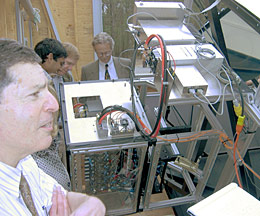
Inauguration day for the all-sky optical SETI scope. Paul Horowitz (left) stands next to the world's most powerful SETI camera (box at center, mounted on the side of the telescope), which he and his students designed and built.
Sky & Telescope: Alan MacRobert
"We observe every clear night," wrote Horowitz in the Nov/Dec 2008 Planetary Report, "and you can check out the operation at The Planetary Society's website."
False alarms happen regularly. In the first two years of observing, there were a few hundred such "events." "Some of these are easily spotted as artifacts," wrote Horowitz. "Others are more persuasive. . . . We re-observe these candidates," both by re-sweeping the site on another night and by enlisting other, more powerful, targeted instruments to track them for longer periods of time. So far, no "event" has repeated. Horowitz hopes someday to build an identical second copy of the 72-inch sky-scanner at another site so the two can observe in parallel. This should reduce the false-event rate to zero and would immediately confirm any actual faint signal from the stars.
On the other side of the continent, two optical SETI programs have been run from Berkeley. One, named SEVENDIP, is a search for nanosecond pulses (directed by SETI@home's Dan Werthimer) using Berkeley's 30-inch automated telescope at Leuschner Observatory in California. As of February 2009 this project had looked at about 10,000 stars and 100 galaxies, according to Werthimer. For the other program, Amy E. Reines and extrasolar-planet hunter Geoffrey Marcy checked high-resolution spectra of 577 Sunlike stars that are more than 2 billion years old for any narrow, continuous laser lines.
The SETI Institute too has built an optical SETI instrument, which has been working on a 1-meter telescope at Lick Observatory in California since 2001. As of January 2004, the Lick Optical SETI Program had observed 3,999 of its 5,039 target stars for 10 minutes each. The instrument divides starlight from the telescope into three beams directed into three high-speed photometers, not just two. This level of redundancy reduces the false-hit rate from about once per night to once per year. "This technique will be adopted by the Harvard [targeted] program as well during a future program upgrade," according to a September 2003 SETI Institute statement. "Iowa State is currently establishing an OSETI program that will also use the triple photomultiplier technique." So does the Berkeley program at Leuschner.
Another optical SETI project was run at Mount Wilson Observatory. Albert Betz (University of Colorado) and Charles Townes (University of California, Berkeley) examined 200 nearby solar-type stars at the 10-micron infrared wavelengths of carbon-dioxide lasers, using a 1.7-meter telescope during times when it was not being employed for its normal infrared observing projects.
Infrared is better than visible light for distant optical signaling because it better penetrates interstellar dust. Moreover, notes Horowitz, "more photons are received for the same pulse energy." It may well be that extraterrestrials have decided that infrared optical signaling is the only way to go, and that if creatures like us were smart enough to be interesting, we would realize this.
In 2000 an Australian optical SETI project named Oz OSETI was set up by Ragbir Bhathal of the University of Western Sydney, using two telescopes (0.4 and 0.3 meters aperture), each with two photometers, in separate domes about 20 meters apart to eliminate false hits from simultaneous noise events. In its first year the project looked at 100 Sunlike stars and 15 globular star clusters. The project was continuing as of 2010. (In May 2009 a probable false alarm in Bhathal's data was overhyped by the Australian press). Bhathal has also considered plans to build a 1-meter wide-sky OSETI survey telescope, rather like a smaller version of Horowitz's wide-sky OSETI telescope in the Northern Hemisphere.
Several other optical SETI projects have been carried out in the past, and more are planned. David Eichler (Ben Gurion University, Israel) and Gregory Beskin (Special Astrophysical Observatory, Russia) have published a paper pointing out that giant "light bucket" cosmic-ray detectors now in operation and under construction could serve as sensitive optical SETI detectors covering many square degrees of sky at once. Another paper exploring this possibility was published (June 2005) by J. Holder (University of Leeds, UK) and four colleagues; they are looking for optical SETI signals in archived data from the 10-meter Whipple cosmic-ray detector. The STACEE cosmic-ray detector in New Mexico has already been used to watch targeted stars for optical signals during its idle time.
Wider Frontiers
Our ideas of the kind of signals that aliens logically "ought" to broadcast, if they're trying to attract cosmic attention, have already changed a lot in the mere half-century of SETI work so far. They'll surely continue to change, perhaps beyond recognition.
For instance, in August 2009 Gregory, James, and Dominic Benford published a paper, based on their attempts at a universal cost analysis for radio-beacon design, concluding that any radio signals coming our way are far more likely to be brief and very infrequent than continuous; are probably at frequencies far above the magic hydrogen frequency or the "water hole" (that is, at least as high as 10 GHz); are probably not very narrowband; and will be aimed radially toward or away from the galactic center, more or less, for the greatest star-catching efficiency in the Galactic Habitable Zone in the midrange of the Milky Way’s disk. And, the transmitting civilization will be too far away to have any prior knowledge of life on Earth no matter how powerful its telescopes may be (due to interstellar absorption). Every recent and current SETI search ignores most or all of these characteristics.
And why assume that radio or light will be the signal medium at all? Another way that aliens might think to communicate, for instance, is by neutrino beams. This idea is not as farfetched as it sounds. Three physicists report (November 2008) that an appropriate beam generator "can be accomplished with presently foreseeable technology. Such signals from an advanced civilization, should they exist, will be eminently detectable in neutrino detectors now under construction."
Looking even farther afield, longtime SETI theorist Allen Tough proposes a wider range of SETI strategies. These include keeping a lookout for alien artifacts in Earth's fossil record or in today's solar system; recognizing signs of distant astro-engineering projects (for instance, planet-sized artificial shapes transiting the faces of stars or signs of other huge constructions); and, on the hypothesis that ETs might already be watching us right now, simply inviting them to come forward. Proposing such ideas means rubbing shoulders with the lunatic fringe of the UFO movement, but these ideas are not unreasonable in principle. If nothing else, negative results in such areas help to put upper limits on very advanced civilizations that might be around us.
After 50 years of no results, however, it's all too easy to overestimate the upper limits that we have already set. We still know extremely little; it's far too early to speak of any "great silence." Compared to the huge radio search space yet to be looked at, all of our SETI projects so far are nothing more than proof-of-concept trial runs. It is humbling to realize that dozens of exasperated civilizations could be blasting Earth right now with radio wakeup calls at dozens of "logical" hailing frequencies, and they would all be easily missed by every SETI search under way or planned.
While today's SETI programs show a widening range of coverage and strategies, they have not even begun to test all the possibilities.
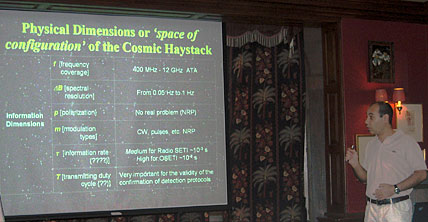
A long, long search lies ahead. At a SETI workshop organized by the Planetary Society at Harvard University in August 2004, Guillermo Lemarchand worked through his estimate that we've examined only a hundred-trillionth of the radio 'search space' waiting to be surveyed.
Sky & Telescope: Alan MacRobert
-------------------
Alan M. MacRobert is a senior editor of Sky & Telescope.
Please send corrections or suggested updates to macrobert [at] SkyandTelescope [dot] com.
 0
0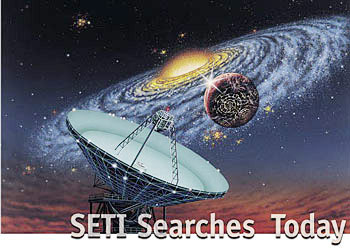










Comments
You must be logged in to post a comment.